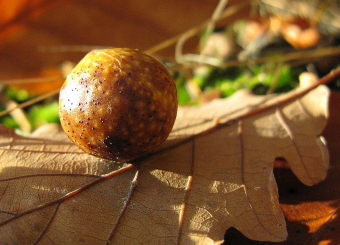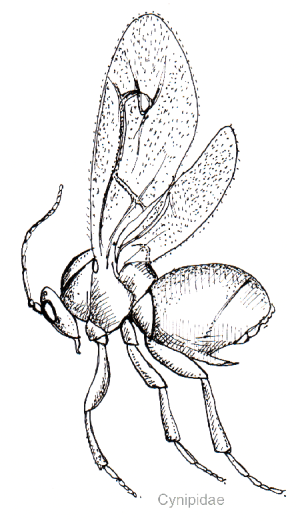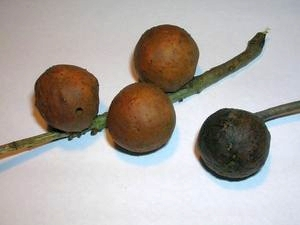
As you guide your shopping cart down an aisle not devoted to foodstuffs, you spot a bag of a dozen pens on sale for an acceptable price. You grab a pack and move on… At one time, you might have had to prepare homemade iron gall ink from oak tree galls.
Oak Tree Galls
What are oak tree galls? These generally round growths are produced by the interaction of plant hormones of an oak tree, combined with growth regulating chemicals produced by gall wasps and other insects or mites. The galls are lightweight and filled with air and fibers. They are rich in gallotannic acid, which is broken down by water into tannic acid, one of the ingredients used to make ink.

History
Oak gall ink or iron gall ink was the common ink in use in Europe from about the 12th century till the 19th century. This ink was water resistant, and would gradually darken with age. It was permanent. Many of the most famous documents of history were written using iron gall ink. One was the Declaration of Independence.
Home School or Family Projects
What makes this such a valuable project for home schoolers? The project of making and using this ink is a dream for the home instructor, because it crosses so many boundaries. It delves into history, art, and science, as well as preservation of important documents. It piques the curiosity of younger ones, and it is easily done at home.
You get to go on a field trip to an oak woods and look for galls. Finding some, you take one or two and open them up on the spot and discuss how they are formed and why they look the way they do on the inside. These will enable you to demonstrate chemical reactions (see below). You can discuss how this ink was of such great historical and social importance.
Materials for Homemade Iron Gall Ink
For a quick, at-home method of making iron gall ink, take a few iron nails. Place them in a small jar with some distilled vinegar. Let that sit until the reaction of the acid vinegar dissolving iron from the nails is complete. Pour the liquid off the residue into a bottle.

In another jar, take some oak galls and crush them. Put them in a Pyrex dish and pour some boiling water over them. Let stand for some time¹, then filter them through a coffee filter, keeping the liquid portion. When you mix the two liquids together, you form ink.
Note that we did not include the binding agent, gum arabic². The ink will gradually darken and lose its usefulness, so you will want to make it just before you use it.
For Added Fun
For added fun, use a feather quill pen and make up your own “historical document.” What a wonderful way to combine history, biology, chemistry, and art all in one package!
1 Allowing sufficient time for a kind of fermentation by means of the mold on the galls will improve ink quality.
2 There are pros and cons for using the binding agent gum arabic. It is not a required ingredient and may be best avoided for the home school project.
Note: You might also enjoy DIY Milk Based Casein Glue
References:

Fascinating. A great home school project for anyone, not just home-schoolers!